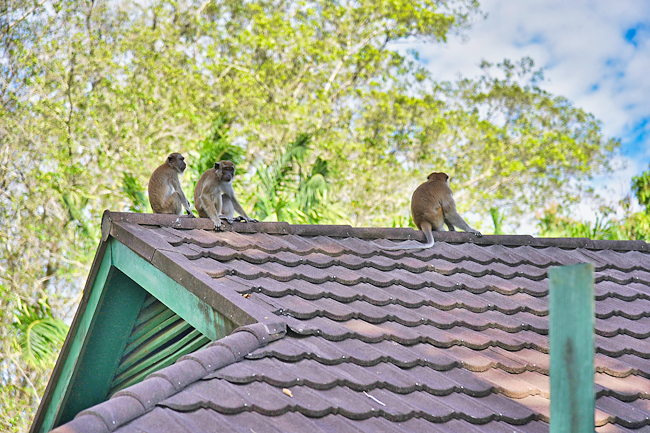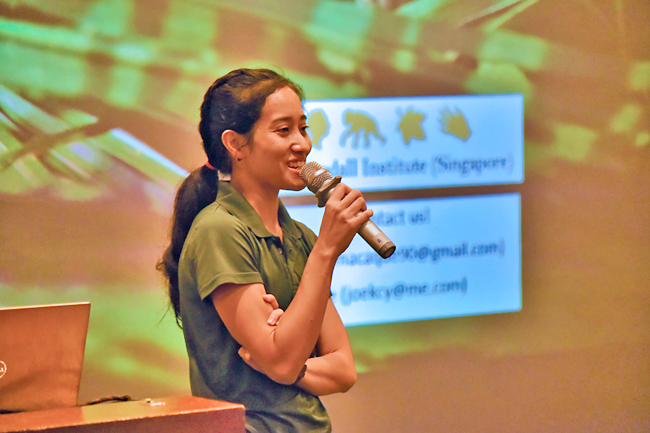Daniel Lim
Brunei Darussalam and the lush rainforest are an inseparable pair, with the natural environment home to a rich biodiversity of flora and fauna.
The rapid expansion of human settlements, towns and cities has threatened to encroach on the habitat of many animals. One such clash in between humans and monkeys.
This was one of the highlights of a new monkey guard training programme in the Sultanate to disseminate information on the proper techniques and knowledge necessary to not only ensure the safety of both humans and monkeys but also to create a healthy and effective boundary that ensures both humans and monkeys can cohabit the same natural environment peacefully.
While some might scoff at monkeys as a nuisance, many of the prevalent monkey species found in the country, including the Long-Tailed Macaque – sometimes referred to as crab-eating macaques and the silvered leaf monkey – plays an important role in the biodiversity of the rainforest.
Monkey guard programme lead from the Jane Goodall Institute Singapore (JGIS) Sabrina Jabbar, who was invited by Brunei Shell Petroleum Company Sdn Bhd (BSP) and Panaga School to conduct talks and training for the first generation of Monkey guards in Brunei, pointed this out.




“The macaques play an important role in the rainforest as they help with forest regeneration through seed dispersion,” she explained.
She noted that there are several species of macaques, especially the Long-Tailed Macaque, that were listed as endangered in 2022 by the International Union for Conservation of Nature (IUCN), due to rapid population decline as well as exploitation and habitat destruction.
One of the objectives of JGIS is to disseminate information on monkey guard, which focusses on the environment, the people and macaques.
“We work a lot with schools and agencies, both locally and internationally, to address urgent matters related to macaques, and we want to address issues that can crop up when they clash with humans for various reasons,” she said
To achieve this, she, along with two other monkey guards Joe Kam and Metta Kartini, trained the first group of monkey guards in Brunei to create an invisible but effective boundary, while also educating the community on the proper conducts to follow.
“We are here as part of an outreach education programme for the community.
Approximately 10 volunteers have stepped up to the plate to learn the skills needed to guard against the macaques in various hotspots where clashes can occur.”
The experts also freely observed the natural behaviours exhibited by the monkeys that roam the area of Panaga to formulate an action plan to create an effective boundary that ensures the safety and comfort of both humans and monkeys.
While forming the first generation of monkey guards might seem like a catch-all solution to the monkey problems, Jabbar said monkey guard is only one of the many steps that need to be taken to achieve the ultimate goal of living in harmony with the natural environment.
“One common misconception people have about monkey guarding is that it is always going to solve the human-macaque conflicts or that we are not going to see macaques anymore, once we have the solution in place.”
“But monkey guarding is not a one-size-fits-all solution. It depends on what the environment, the people, the community and the animal are.”
One of these factors that Jabbar highlighted is the lack of green spaces that the macaques can safely inhabit. “We want to set an invisible and effective boundary that is healthy for humans and macaques.”
To create the boundary, not only does monkey guarding need to be implemented in a proper manner but also basic macaque behaviour etiquette for the community.
“Knowing how to properly manage them in various scenarios such as how to walk past them, how to manage your distance between you and them, to how to react in situations where they enter prohibited areas – this knowledge can help to reduce conflicts.
“It is everyone’s responsibility and we want people to be empowered to take action while the situation can be controlled,” she said.
Other factors that can adversely affect clashes between humans and macaques are feeding or having an unnatural source of food.
Jabbar shared that the first thing to remember is to refrain from feeding them at all costs.
“We want to keep them as wild as we can and they have enough natural food in the forest.
We do not want them to be dependent on humans for food and start to lose fear for humans,” she said.
“Secondly, always abide by at least two or three metres of distance between you and the macaques so that each party has enough space to move forward or retreat.”
Having visited the Sultanate for the first time, the Singaporean and her colleagues expressed their delight in observing such a rich biodiversity, compared to the city state’s concrete jungle.
“I am very impressed by the biodiversity and the macaques’ behaviours here. They look healthy and spend a lot of time in the forest foraging, and they have a very healthy fear towards people. That’s good.”
She noted how the local biodiversity also leads to various species having healthy interactions with one another.
While the group’s stay in the Sultanate was brief, Jabbar expressed hope that the first generation of monkey guards will put the knowledge and skills acquired to good use in not only maintaining that healthy boundary between humans and monkeys but also disseminating them to the wider community.
“The ultimate goal is long-term sustainability, as the trainees become the trainers, training others on the same proper skills and knowledge on monkey guarding. It does not have to be learning how to properly monkey guard, but just knowing the basic behavioural etiquette can go a long way in helping humans and macaques co-habit in harmony,” she added.







